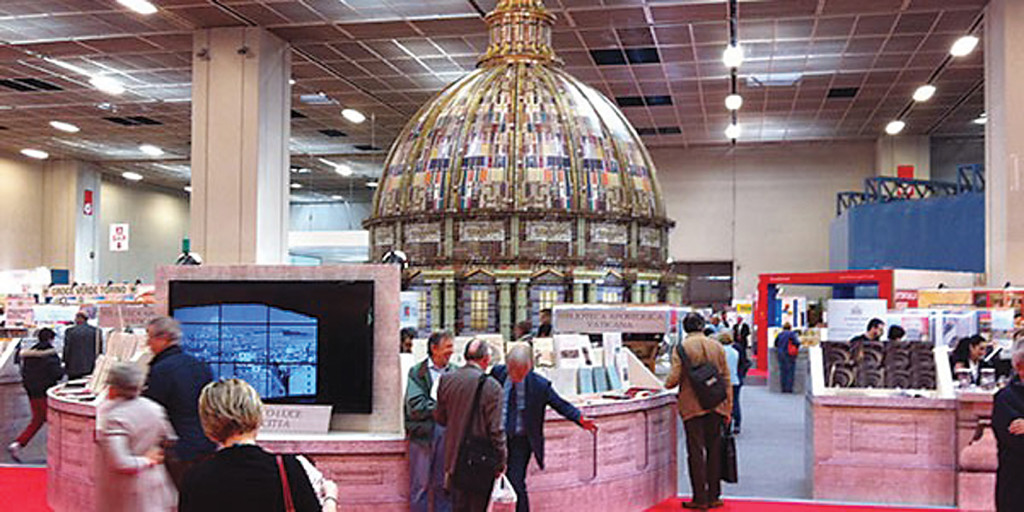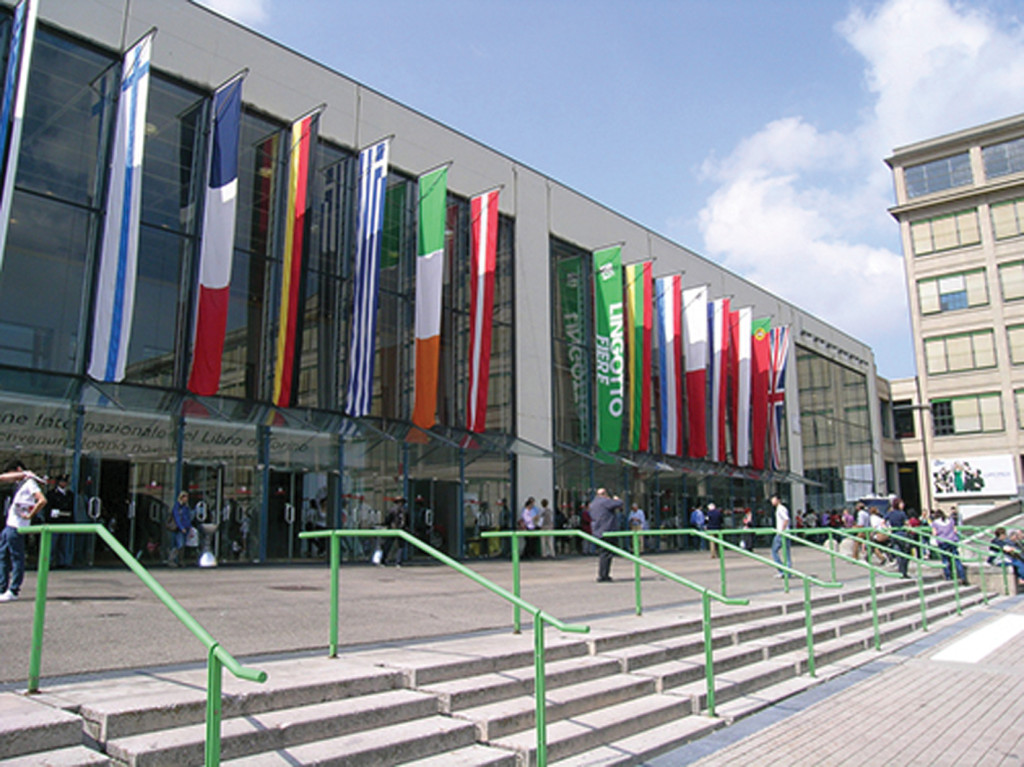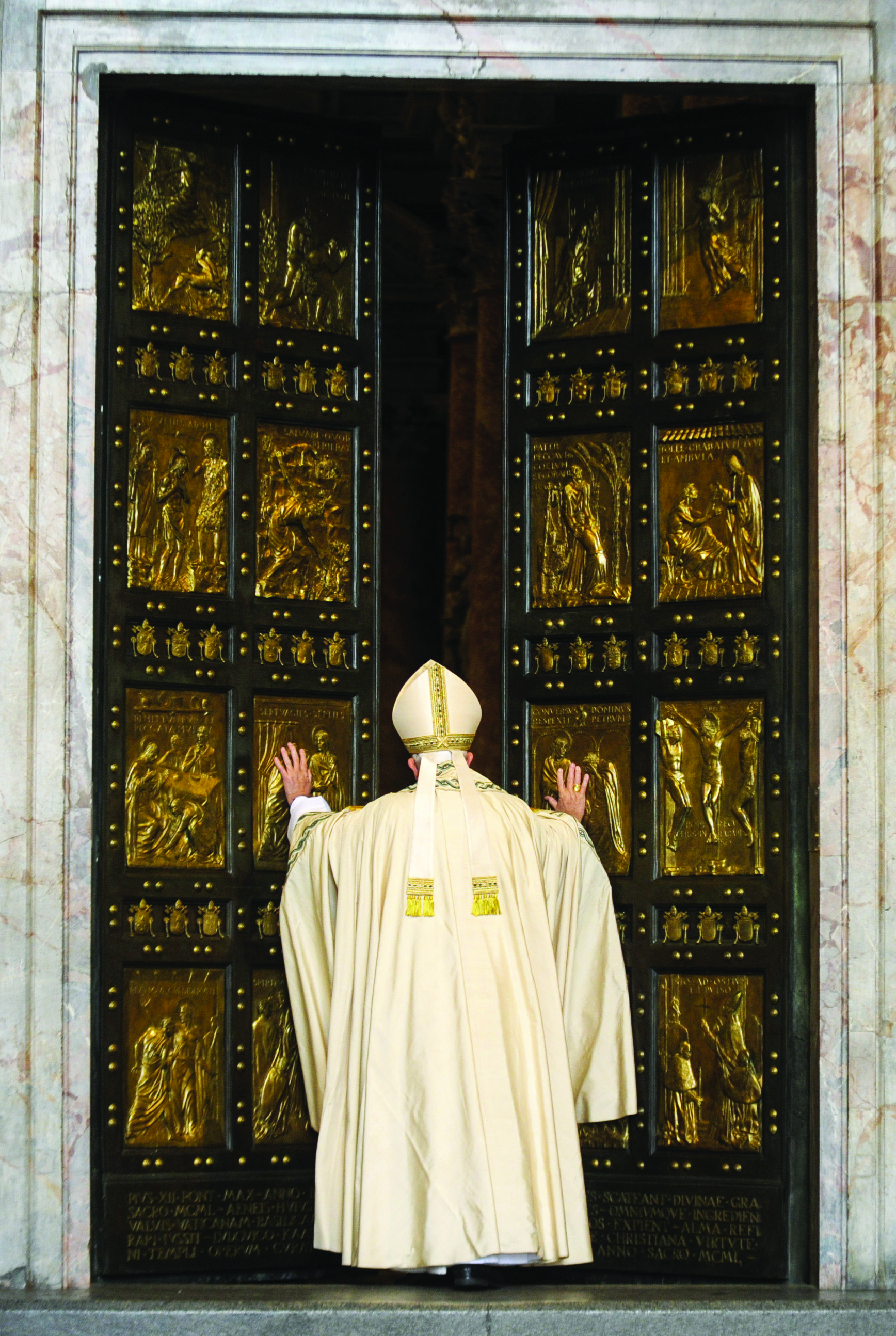
The unusual Vatican Press book display centered on a “cupola of books” in the shape of Michelangelo’s cupola above St. Peter’s Basilica.
More than 1,000 different books spread out on tables in the shadow of a great dome constructed out of books in the shape of the cupola of St. Peter’s Basilica. Such was the Holy See’s booth at the Salone Internazionale del Libro di Torino (Turin International Book Fair) which this year made the Holy See its “guest of honor.”
The book fair, including the Vatican’s booth, opened on May 8 in the presence of Italy’s Minister of Culture Dario Franceschini. “I would like to thank the Holy See for having given greater prestige to this year’s edition of the book fair,” Franceschini said.
“A very impressive display,” said Rolando Picchioni, president of the book fair and of the Italian Foundation for Books, Music and Culture, of the “cupola of books.” The display “will remain in the history of the book fair,” he said. Ernesto Ferrero, editorial director of the fair, said the Holy See’s exhibit “is the most beautiful we have seen in 27 years, a metaphor that has meaning for all of us: without these ‘bricks of paper’ nothing could be built.”
The Libreria Editrice Vaticana (the Italian name of the Vatican Press) displayed 700 volumes in its booth. And one of the four “hemicycles” built out from the Cupola was devoted entirely to books by and about Pope Francis published by the Press.

Fr. Giuseppe Costa, director of the Vatica Press, and other publishers presenting books at the May 2014 Turin Book Fair.
Next to the Vatican Press books were also publications from other Vatican offices: the Vatican Museums, the Vatican Library, the Pontifical Council for Culture, and the various Pontifical Academies.
Also present at the Holy See’s booth, in addition to books, were some rare items from the Vatican: archeological discoveries like Roman marble sculptures from the third and fourth centuries; a copy of The Iliad from 1477; a book of hours from the 1400s; an illustration of the pit of hell from Dante’s Divine Comedy drawn by Sandro Botticelli. There were also four historic letters: one written by Count Camillo di Cavour, the other three addressed to Pope Pius IX by St. John Bosco, by Carlo Alberto, King of Sardinia, and by the King of Italy, Vittorio Emanuele.
Among the other Vatican departments represented at the booth in Turin were the Vatican Secret Archive, the Pontifical Commission for Sacred Art, the l’Ufficio Filatelico e Numismatico (the stamp and coin office) and Vatican Radio.
The annual market for religious books in Italy is about 13.5 million copies for a total sale price of nearly 100 million euro (about $140 million). In the first 12 months of the pontificate of Pope Francis, 111 works by him were published, and 139 books about him, for a total of 250 books in a single year, which has caused people in Italy to speak of a true “Francis effect” in Italian publishing.
In 2013, 954 publishers, 650 of them not Catholic but secular, published at least one title on a religious subject, totaling 5,000 books, about 10 percent of the entire book publishing market in Italy in 2013.

Fr. Costa, the director of Vatica Press, is the first person on the left. Next to him, the mayor of Turin, Piero Fastino.
These figures and statistics were presented during a round-table discussion on religious book publishing on the morning of May 9, organized by Father Costa of the Vatican Press and by the Union of Italian Catholic Book Publishers.
The discussion was moderated by Giuliano Vigini, an essayist, scholar of religious literature, and professor of the Sociology of Contemporary Publishing at the Catholic University of Milan. Vigini said, “Catholic publishing represents a conspicuous part in world book publishing, both in terms of numbers of books printed and in terms of numbers sold.” In recent years, he continued, “interest in the work of Benedict XVI and now in that of Pope Francis has been growing worldwide, with phenomena of publishing and sales comparable to a true publishing ‘tsunami.’ This has greatly contributed to helping quite a few small publishing houses to stay in business.”
Still, Vigini said, “though religious publishing does occupy a specific, consistent space within the general market for books, it still and increasingly must confront the complexity of a business in which the methods of producing and distributing books are continually changing.”
Four speakers then spoke about the situation of religious publishing in four different countries: Italy, the United States, Germany, and Portugal. The situation in Italy was analyzed by Giovanni Cappelletto, president of the Centro Ambrosiano and of the Union of Italian Catholic Book Publishers. “The religious book is shaking off the definition of ‘niche publication’ which accompanied it over the centuries, carving out a space where the themes it deals with are of interest to a wide range of readers in an ever more secularized society.”

A new stamp issued for the occasion by the Holy See. Bottom, the locations of three Vatican Press bookstores in Rome.
Cappelletto noted that there is a difference in the attitude of secular and religious book publishers. “Religious editors keep an eye on their catalogue,” he said. “They wish to add books that will persist over time, and be sold for years to come. Thus, fewer ‘instant’ books, more long, steady sellers. The secular publishers, on the other hand, see in the religious book market an opportunity to intercept readers with books in their catalogue which will attract new readers to them.” He added: “Secular publishers are now active in all the traditional religious sectors” and the growth of religious titles from these publishers has tripled from 1.5% in 2009 to 4.5% in 2012, with forecasts of another doubling, to about 8%, in the next few years.
Gregory Erlandson, president of the Our Sunday Visitor publishing house in Fort Wayne, Indiana, said that the Catholic book market is a “difficult” one because it is fragmented. Demographic, political and cultural divisions in the market compel Catholic publishers to try new strategies to reach a public “extremely large but also extremely differentiated.”
[Editor’s Note: English-language publishers who would like to contact the Vatican Press about co-publishing in English a work the Vatican Press has already published in Italian, may send an initial request to the Vatican Press via the editor of this magazine, email: editor@insidethevatican.com]







Facebook Comments